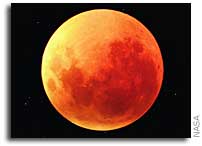Tuesday’s Total Lunar Eclipse Favors Far West

Note to Editors/Producers: This release is accompanied by publication-quality illustrations and a broadcast-quality animation; see details below. More information for the general public is available at http://SkyandTelescope.com/community/skyblog/observingblog/9282371.html
The second total lunar eclipse of 2007 happens in the hours after midnight on Tuesday morning, August 28th. For North Americans, the event takes place with the Moon sinking low in the west before or during dawn.
The farther west you are, the better. In the Pacific time zone, the partial eclipse begins at 1:51 a.m. PDT. Totality, when the Moon is completely in shadow, runs from 2:52 to 3:23 a.m. PDT. The last partial stage ends at 5:24 a.m. PDT, at which time the Moon is still fairly well up in the southwest as dawn approaches.
Farther east, these phases happen an hour later by the clock in each successive time zone and — more importantly — nearer to sunrise. In the Midwest you’ll see the Moon approach the horizon and become lost in the light of dawn while totality is still in progress. And in New England the Moon will be low and the sky quite bright before totality even starts.
Here are the key event times for the eclipse, given for four North American time zones. Compare these with your local times of sunrise and moonset, which depend on your location (dashes: event not visible):
TOTAL ECLIPSE OF THE MOON, August 28, 2007
Eclipse stage PDT MDT CDT EDT
Partial eclipse begins 1:51 a.m. 2:51 a.m. 3:51 a.m. 4:51 a.m.
Total eclipse begins 2:52 a.m. 3:52 a.m. 4:52 a.m. 5:52 a.m.
Total eclipse ends 4:23 a.m. 5:23 a.m. 6:23 a.m. --
Partial eclipse ends 5:24 a.m. 6:24 a.m. -- --
The previous total lunar eclipse, last March 3rd, favored eastern North America and Europe. The next one, on February 20, 2008, will be situated in the sky to give virtually everyone in the Americas a good view of it.
How and Why
A total lunar eclipse occurs when the Sun, Earth, and Moon form a nearly straight line in space, so that the full Moon passes through Earth’s shadow. Unlike a solar eclipse, which requires special equipment to observe safely, you can watch a lunar eclipse with your unaided eyes. Binoculars or a telescope will enhance the view dramatically.
The outer part of Earth’s shadow, called the penumbra, creates only slight dusky shading on the lunar disk. But as the Moon begins to move into the central and darkest part of Earth’s shadow, the umbra, there’s an obvious and ever-larger “bite” in the full Moon. The partial eclipse is then under way.
The total eclipse begins when the Moon is fully within the umbra. On August 28th, totality lasts 1 hour 31 minutes. But the Moon likely won’t disappear completely. It usually glows as an eerie, coppery red disk in the sky, as sunlight scattered around the edge of our atmosphere paints the lunar surface with a warm glow. This is light from all the sunrises and sunsets that are in progress around Earth at the time.
Several publication-quality illustrations and a broadcast-quality animation are available. Permission is granted for one-time, nonexclusive use in print and broadcast media, as long as appropriate credits (as noted in each caption) are included. Web publication must include a link to SkyandTelescope.com. To download the graphics and captions, please go to the online version of this press release:









